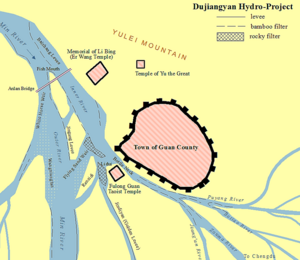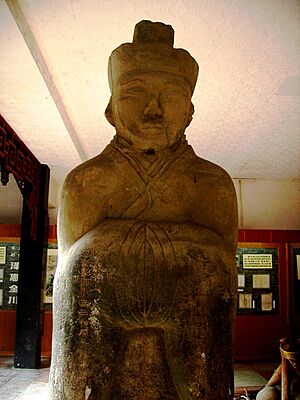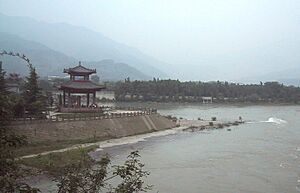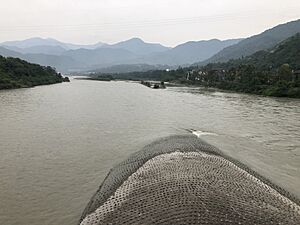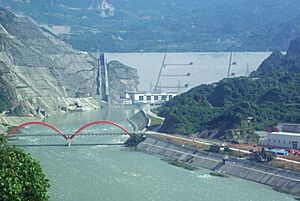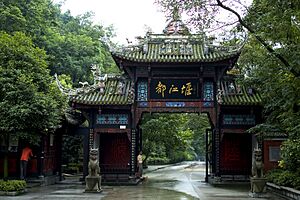Dujiangyan facts for kids
Quick facts for kids UNESCO World Heritage Site |
|
|---|---|
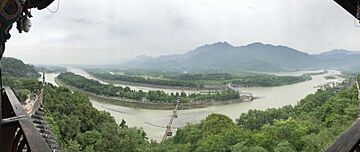
Dujiangyan irrigation system
|
|
| Location | Dujiangyan City, Chengdu, Sichuan, China |
| Part of | Mount Qingcheng and the Dujiangyan Irrigation System |
| Criteria | Cultural: (ii)(iv)(vi) |
| Inscription | 2000 (24th Session) |
The Dujiangyan (Chinese: 都江堰; pinyin: Dūjiāngyàn) is an amazing ancient water system in Dujiangyan City, Sichuan, China. It was built around 256 BC by the State of Qin. This system was made to control floods and bring water to farms. It is still used today, over 2,250 years later!
The Dujiangyan system works with the Min River. This river is the longest branch of the Yangtze River. The area is in the west of the Chengdu Plain. Before Dujiangyan, the Min River often flooded this flat land. This happened because the fast mountain water slowed down and dropped a lot of mud.
King Zhao of Qin asked for this project to be built. Instead of building a simple dam, the builders found a new way. They channeled and divided the river's water. This smart system still waters over 5,300 square kilometers (2,000 sq mi) of land. It helps with flood control, irrigation, and water transport. The Dujiangyan is one of China's "three great hydraulic engineering projects of the Qin" dynasty. In 2000, it became a World Heritage List site.
Contents
History of Dujiangyan
Why Dujiangyan Was Built
During the Warring States period, people living near the Min River had big problems with floods every year. A smart engineer named Li Bing studied the river. He found that melting snow from the mountains made the river swell. When this fast water reached the flat land, it slowed down. This caused mud to build up and the river to overflow.
Building a simple dam was one idea. But the Qin rulers wanted to keep the river open for boats. These boats carried supplies for their soldiers. So, Li Bing came up with a different plan. He decided to build an artificial wall to guide some of the river's water. Then, he would cut a channel through Mount Yulei. This channel would send the extra water to the dry Chengdu Plain.
How Dujiangyan Was Built
King Zhao of Qin gave a lot of money for the project. Tens of thousands of workers were sent to build it. The first part was a wall shaped like a fish's mouth. It was made from long, sausage-shaped baskets filled with stones. These baskets were held in place by wooden tripods. This "fish mouth" wall took four years to finish.
Cutting the channel through the mountain was much harder. Back then, there was no gunpowder. It would have taken many decades to cut through the rock by hand. Li Bing had a clever idea. Workers would heat the rocks with fire. Then, they would pour cold water on them. This made the rocks crack, making them easier to remove. After eight years, a 20-meter (66 ft) wide channel was dug through the mountain.
Dujiangyan's Impact and Changes
After the system was finished, the floods stopped. The irrigation made Sichuan a very rich farming area. It was once the most productive agricultural region in China. Some people say it even made the local people more relaxed. With no floods and good harvests, they had more free time.
Over time, the system faced challenges. Wars and changes in rulers sometimes damaged it. The original Dujiangyan system was destroyed by a big earthquake in 1933. But it was rebuilt by Zhang Yuan and his sons. Today, Dujiangyan is a major place for tourists to visit.
The 2008 Sichuan Earthquake
On May 12, 2008, a huge earthquake hit Sichuan. The Dujiangyan area was affected. Early reports said that the main wall, called the Yuzui Levee, cracked. But it was not badly damaged. The river's water could still be seen flowing as planned.
How Dujiangyan Works
The Dujiangyan system has three main parts. They all work together to prevent floods and bring water to farms.
- The Yuzui or Fish Mouth Levee (Chinese: 鱼嘴) looks like a fish's mouth. This artificial wall splits the river into two streams. One is the inner stream, which is deep and narrow. The other is the outer stream, which is wide and shallow. This design is very smart. In dry times, the inner stream takes about 60% of the water for irrigation. During floods, it takes only 40%. This protects people from too much water. The outer stream carries away the rest of the water and most of the mud.
- The Feishayan or Flying Sand Weir (Chinese: 飞沙堰) is a 200-meter (660 ft) wide opening. It connects the inner and outer streams. This weir helps prevent floods. It lets the swirling water drain extra water from the inner stream to the outer stream. This swirling also washes away any mud that didn't go into the outer stream. Today, a strong concrete weir has replaced the old bamboo baskets.
- The Baopingkou or Bottle-Neck Channel (Chinese: 宝瓶口) is the last part. This channel was cut through the mountain. It sends water to the farms on the Chengdu Plain. Its narrow entrance, which gives it its name, acts like a gate. It creates a swirling flow that sends extra water over the Flying Sand Weir. This helps prevent floods.
Anlan Suspension Bridge
The Anlan, or Couple's Bridge, crosses the entire river. It connects the artificial island to both river banks. It is known as one of China's "Five Ancient Bridges." The first bridge here only crossed the inner stream. It connected the levee to Mount Yulei.
In 1803, during the Qing dynasty, a local man named He Xiande and his wife suggested building a new bridge. It was made of wood and bamboo. It crossed both streams and was called Couple's Bridge in their honor. The bridge you see today is a modern one, built in the 1970s.
Geography of Dujiangyan
Location of the System
The Dujiangyan irrigation system is in the western part of the Chengdu flatlands. It sits where the Sichuan basin meets the Qinghai-Tibet plateau. This location is important because it's where the fast-flowing mountain river meets the flat plain.
Geology and Land Features
The Dujiangyan system is at a key point where two types of land meet. These are the western plateau mountains and the Chengdu Plain. It is also in the area where the Longmen Mountains extend. This region is known for its fault lines.
The land around Dujiangyan is higher in the northwest and lower in the southeast. The western part is the southern section of the Longmen Mountains. Here, the mountains are below 3,000 meters (9,800 ft) high. The eastern part is the Chengdu Plain, which is about 720 meters (2,360 ft) high.
Water Flow (Hydrology)
The Dujiangyan irrigation system was built at the start of the Minjiang River. On average, 15.082 billion cubic meters (532.6 billion cu ft) of water flow into it each year. There are two main water stations upstream on the Minjiang River. One is the Zipingpu Dam, which controls most of the river's water. The other is the Yangliuping Dam.
Important Temples
Two Kings Temple
The Erwang, or Two Kings Temple, is on the river bank at the foot of Mount Yulei. It was originally a temple for an ancient Shu king. Later, locals renamed it.
This temple complex is made of wood and follows old Chinese temple designs. It has a main hall with a modern statue of Li Bing. This hall opens onto a courtyard with a stage for operas. On Li Bing's birthday, local operas were performed. On Tomb Sweeping Day, a Water Throwing Festival is held here.
The back hall has a modern statue of the god Erlang Shen. People believed Erlang was Li Bing's son. Above the temple is Guanlantin Pavilion. It has wise words from Li Bing, like: "When the river flows in zigzags, cut a straight channel; when the riverbed is wide and shallow, dig it deeper."
Dragon-Taming Temple
The Fulongguan, or Dragon-Taming Temple, is in Lidui Park. It was first built in the third century. After Li Bing died, a hall was built here to honor him. The temple was then renamed to remember the stories about him fighting dragons. It is said that Erlang Shen, Li Bing's legendary son, chained a dragon here. This dragon had been captured at the River God Temple. This act is believed to have protected the region from floods ever since.
During the East Han dynasty, a statue of Li Bing was placed in the river. It helped people check the water level. If the water rose above his shoulders, it meant a flood. If it fell below his calves, it meant a drought. This statue was found in the river in 1974. It is now on display in the main hall. It is the oldest known stone statue of a human in China.
See also
- Turfan water system
- Grand Canal of China


